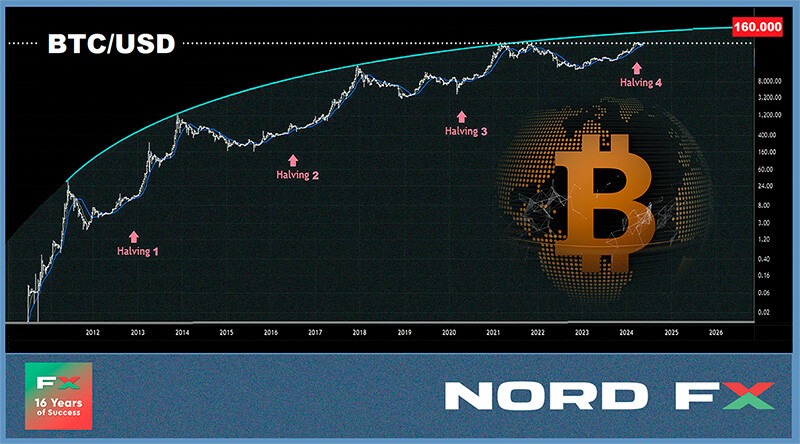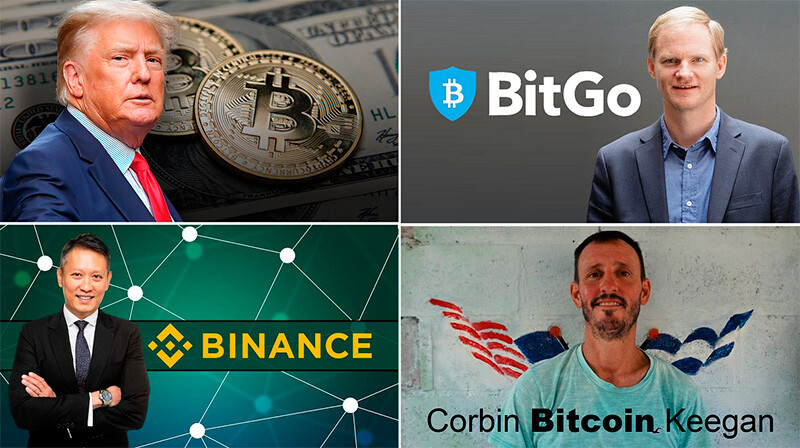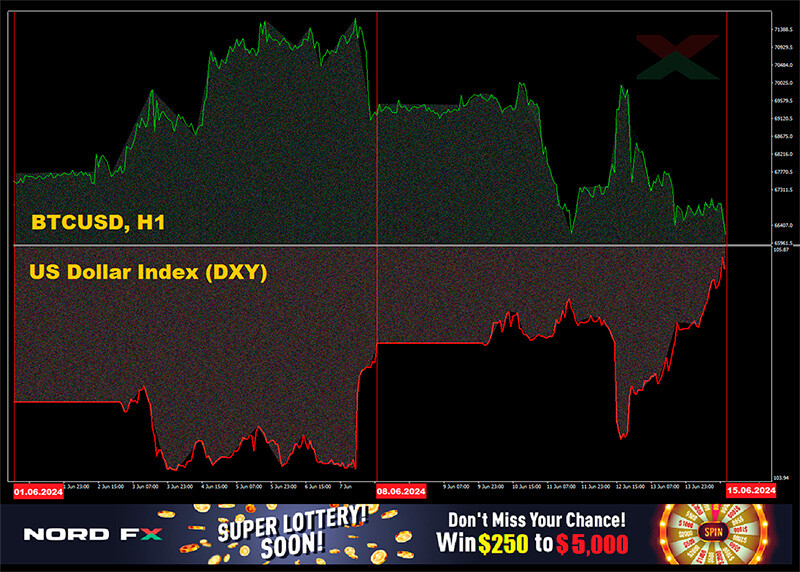Forex and Cryptocurrency Forecast for 03 – 07 June 2024
EUR/USD: Awaiting a Turbulent Week
Recall that Monday, 27 May was a holiday in the US. However, on Tuesday, dollar bulls took control, and the DXY Index started to rise, bolstered by a significant increase in the US Consumer Confidence Index (from 97.5 to 102.0 against a forecast of 96.0). Consequently, EUR/USD moved southward.
Pressure on the euro was also due to expectations that the European Central Bank (ECB) is likely to cut the key interest rate by 25 basis points (bps) from 4.50% to 4.25% at its meeting on 06 June. This intention was confirmed by the head of the Bank of Finland, Olli Rehn, who stated on Monday that he considered it timely to transition to dovish rhetoric in June. Similar opinions were expressed by his colleague François Villeroy de Galhau, head of the Bank of France, and on Tuesday, 28 May, by Robert Holzmann, head of the Bank of Austria.
Unlike the dovish stance of European officials, representatives of the Federal Reserve (Fed) take a more stringent position and want to ensure that US inflation is steadily moving towards the 2.0% target.
Recall that the report released on 15 May by the US Bureau of Labour Statistics (BLS) showed that the Consumer Price Index (CPI) decreased from 0.4% to 0.3% month-on-month (m/m) against a forecast of 0.4%. Year-on-year, inflation also fell from 3.5% to 3.4%. Retail sales demonstrated an even stronger decline, dropping from 0.6% to 0.0% m/m (forecast was 0.4%). These data indicated that although inflation is resisting in some areas, it is generally declining. If previously market participants expected the first rate cut at the end of 2024 or even early 2025, after the publication of this data, talks about a possible Fed rate cut already this autumn resumed. Before the release of the preliminary US GDP data, the probability of a rate cut in September was 41%.
The report published on Thursday, 30 May by the Bureau of Economic Analysis showed that, according to preliminary data, US economic growth in Q1 slowed significantly to an annualized rate of 1.3%, below the forecast of 1.6% and Q4 2023's figure of 3.4%.
Experts attribute the weak GDP growth at the beginning of this year mainly to the dynamics of consumer spending. In Q1, consumer spending increased by 2.0%, not the previously expected 2.5%. The US Department of Commerce's revised data also changed the assessment of the Core Personal Consumption Expenditures (PCE) index, which excludes energy and food prices. At the end of Q1, the figure was 3.6%, not 3.7%. Analysts believe that this decline in all indicators was caused by a combination of factors: the depletion of funds accumulated by the population during the COVID-19 pandemic, the Fed's cycle of monetary tightening, and restrained income growth.
Against this backdrop, the dollar weakened slightly, and EUR/USD moved north. It received another bullish impulse after Eurostat presented on Friday, 31 May, a preliminary estimate of inflation in the Eurozone, which accelerated for the first time this year. Thus, the annual growth rate of consumer prices (CPI) in May was 2.6% compared to 2.4% in April, the lowest since November last year. The consensus forecast expected inflation to accelerate only to 2.5%. Core inflation (CPI Core), which excludes energy and food prices, also increased from 2.7% in April to 2.9% in May (forecast was 2.8%). This was a wake-up call for investors who had hoped that the ECB would not only cut rates once this year but continue to do so.
Towards the end of the working week, market attention focused on US consumer market data. According to the Bureau of Economic Analysis, inflation in the country, measured by the Personal Consumption Expenditures (PCE) Price Index, remained stable in April at 2.7% y/y. The Core PCE, which excludes volatile food and energy prices, rose by 2.8% y/y, matching the forecast. Other report details showed that personal incomes rose by 0.3% m/m in April, while personal spending increased by 0.2%.
After these data, the DXY Dollar Index was under slight pressure, and EUR/USD received a third bullish impulse. However, it did not last long, and ultimately, after all these fluctuations, EUR/USD returned to the Pivot Point of the last two and a half weeks, finishing at 1.0848. Regarding the analysts' forecast for the near future, as of the evening of 31 May, all of them (100%) voted for the dollar to strengthen. This forecast is understandable given the expected ECB decision on a rate cut on 06 June. But what if it doesn't happen? Or perhaps this forecast has already been priced into the market? In that case, instead of the dollar strengthening, we could see the opposite reaction.
All trend indicators on D1 are 100% green, while only 50% of oscillators are green, with 15% red and 35% neutral-grey.
The nearest support for the pair lies in the 1.0830-1.0840 zone, followed by 1.0800-1.0810, 1.0725-1.0740, 1.0665-1.0680, 1.0600-1.0620. Resistance zones are in the regions of 1.0880-1.0895, 1.0925-1.0940, 1.0980-1.1010, 1.1050, 1.1100-1.1140.
The upcoming week seems to be very eventful and volatile. On Monday, 03 June, and Wednesday, 05 June, the US Manufacturing and Services PMI data will be released. On 04, 06, and 07 June, there will be a slew of statistics from the US labour market, including Friday's crucial data on the unemployment rate and the number of new non-farm jobs (NFP). The most turbulent day of the week, however, is likely to be Thursday, 06 June. On this day, retail sales data for the Eurozone will be released first, followed by the ECB meeting. The market will be focused not only on the ECB's rate decision but also on the subsequent press conference and comments on future monetary policy.
GBP/USD: Foggy Times, Foggy Forecasts
We've previously written that the prospects for the British currency, as well as the national economy, look rather foggy. The Business Activity Index (PMI) showed a decline, and not just it. Much of the pessimism is related to the sharp drop in retail sales in April, which fell by 2.7% y/y compared to the previous growth rate of 0.4%. Additional uncertainty comes from the fact that snap parliamentary elections are scheduled for 04 July. Prime Minister Rishi Sunak stated that "economic instability is just the beginning." This sounds frightening, doesn't it? If this is just the beginning, what lies ahead? Surprisingly, despite this situation, the pound has been strengthening since 22 April. During this period, GBP/USD rose by 500 points and on 28 May recorded a local maximum at the round figure of 1.2800.
Regarding the timing of the Bank of England's (BoE) interest rate cut, everything also seems as foggy as the Thames mist. JP Morgan (JPM) analysts, while adhering to their forecast for a rate cut in August, warn that "the risks have clearly shifted towards a later reduction. The question now is whether the Bank of England will be able to ease its policy at all this year." Goldman Sachs, Deutsche Bank, and HSBC strategists have also adjusted their rate cut forecasts, moving the date from June to August.
GBP/USD ended the week at 1.2741. Economists at Singapore's United Overseas Bank (UOB) believe that the current strengthening of the British currency has ended. UOB considers that over the next 1-3 weeks, "the pound is likely to trade with a downward bias, but a more significant pullback would require breaking below 1.2670. On the other hand, if the pound breaks above 1.2770 (the 'strong resistance' level), it would indicate that it will likely trade within a range rather than pulling back lower."
The median forecast of analysts for the near term is as follows: 75% voted for the pair to move south, while the remaining 25% voted for a northward movement.
As for technical analysis, unlike the experts, all 100% of trend indicators and oscillators on D1 point north, although 15% of the latter signal overbought conditions. If the pair continues to fall, support levels and zones are at 1.2670-1.2700, 1.2575-1.2600, 1.2540, 1.2445-1.2465, 1.2405, 1.2300-1.2330. If the pair rises, it will encounter resistance at levels 1.2760, 1.2800-1.2820, 1.2885-1.2900.
No significant economic statistics are scheduled to be released in the UK next week.
continued below...







